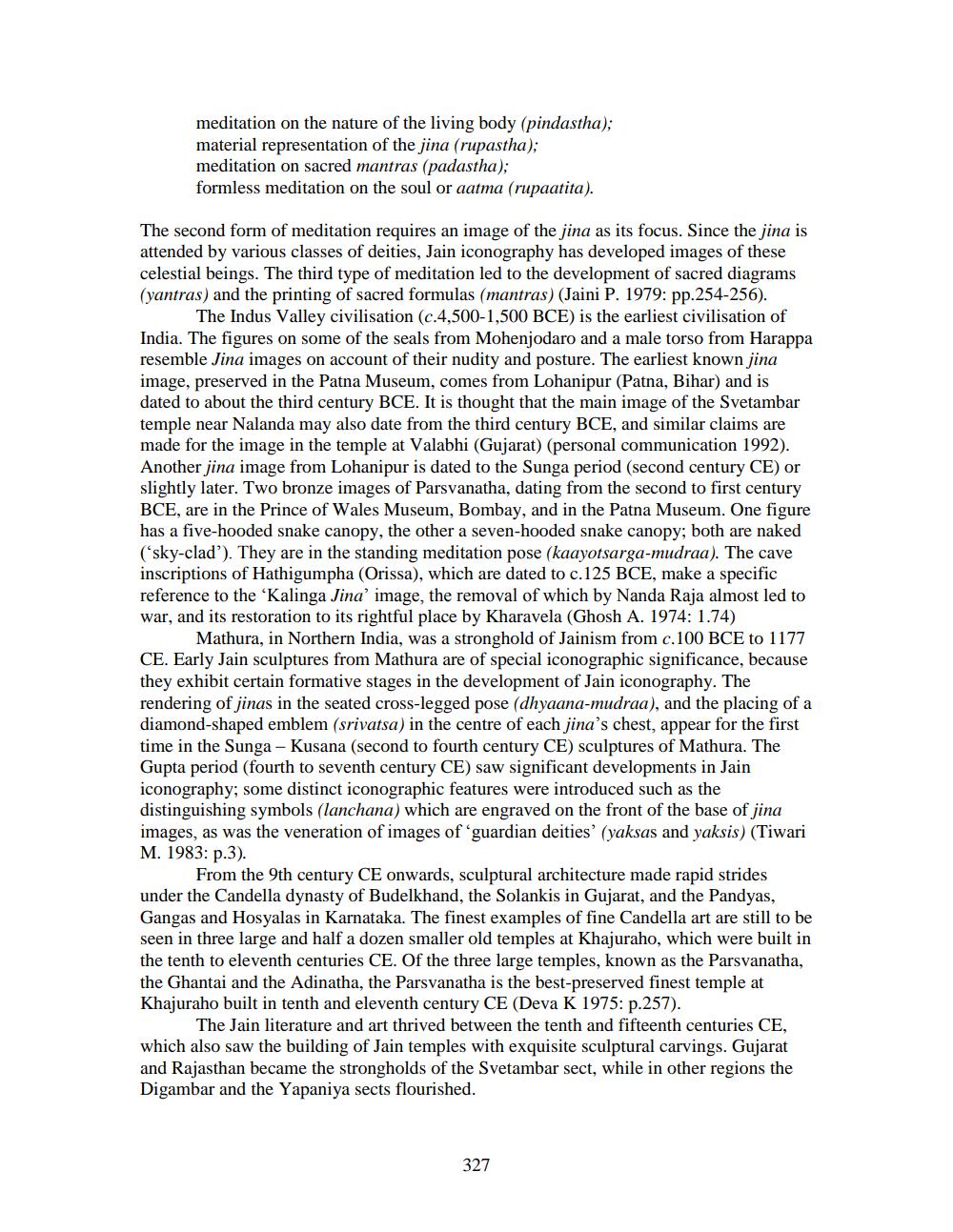________________
meditation on the nature of the living body (pindastha); material representation of the jina (rupastha); meditation on sacred mantras (padastha); formless meditation on the soul or aatma (rupaatita).
The second form of meditation requires an image of the jina as its focus. Since the jina is attended by various classes of deities, Jain iconography has developed images of these celestial beings. The third type of meditation led to the development of sacred diagrams (yantras) and the printing of sacred formulas (mantras) (Jaini P. 1979: pp.254-256).
The Indus Valley civilisation (c.4,500-1,500 BCE) is the earliest civilisation of India. The figures on some of the seals from Mohenjodaro and a male torso from Harappa resemble Jina images on account of their nudity and posture. The earliest known jina image, preserved in the Patna Museum, comes from Lohanipur (Patna, Bihar) and is dated to about the third century BCE. It is thought that the main image of the Svetambar temple near Nalanda may also date from the third century BCE, and similar claims are made for the image in the temple at Valabhi (Gujarat) (personal communication 1992). Another jina image from Lohanipur is dated to the Sunga period (second century CE) or slightly later. Two bronze images of Parsvanatha, dating from the second to first century BCE, are in the Prince of Wales Museum, Bombay, and in the Patna Museum. One figure has a five-hooded snake canopy, the other a seven-hooded snake canopy; both are naked (sky-clad'). They are in the standing meditation pose (kaayotsarga-mudraa). The cave inscriptions of Hathigumpha (Orissa), which are dated to c.125 BCE, make a specific reference to the Kalinga Jina' image, the removal of which by Nanda Raja almost led to war, and its restoration to its rightful place by Kharavela (Ghosh A. 1974: 1.74)
Mathura, in Northern India, was a stronghold of Jainism from c. 100 BCE to 1177 CE. Early Jain sculptures from Mathura are of special iconographic significance, because they exhibit certain formative stages in the development of Jain iconography. The rendering of jinas in the seated cross-legged pose (dhyaana-mudraa), and the placing of a diamond-shaped emblem (srivatsa) in the centre of each jina's chest, appear for the first time in the Sunga - Kusana (second to fourth century CE) sculptures of Mathura. The Gupta period (fourth to seventh century CE) saw significant developments in Jain iconography; some distinct iconographic features were introduced such as the distinguishing symbols (lanchana) which are engraved on the front of the base of jina images, as was the veneration of images of guardian deities' (yaksas and yaksis) (Tiwari M. 1983: p.3).
From the 9th century CE onwards, sculptural architecture made rapid strides under the Candella dynasty of Budelkhand, the Solankis in Gujarat, and the Pandyas, Gangas and Hosyalas in Karnataka. The finest examples of fine Candella art are still to be seen in three large and half a dozen smaller old temples at Khajuraho, which were built in the tenth to eleventh centuries CE. Of the three large temples, known as the Parsvanatha, the Ghantai and the Adinatha, the Parsvanatha is the best-preserved finest temple at Khajuraho built in tenth and eleventh century CE (Deva K 1975: p.257).
The Jain literature and art thrived between the tenth and fifteenth centuries CE, which also saw the building of Jain temples with exquisite sculptural carvings. Gujarat and Rajasthan became the strongholds of the Svetambar sect, while in other regions the Digambar and the Yapaniya sects flourished.
327




